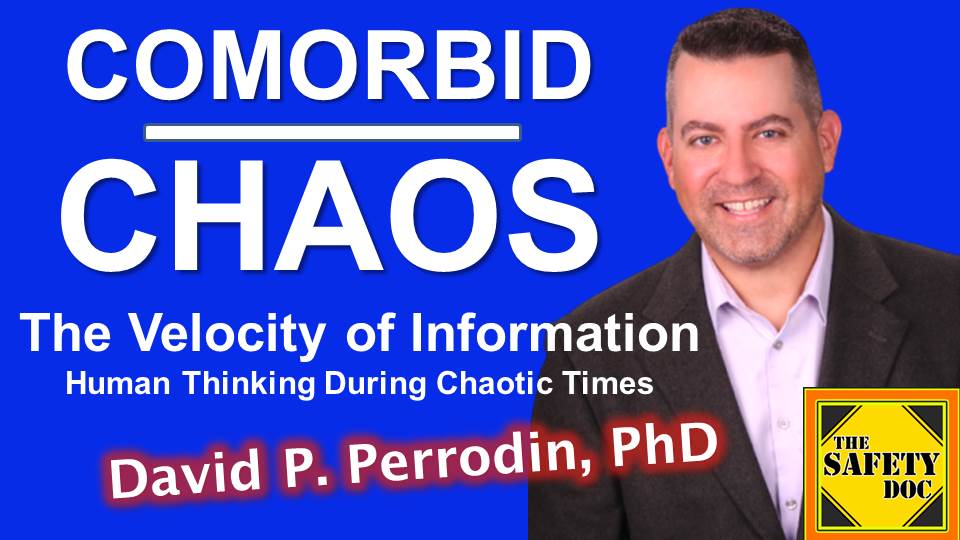Comorbid Chaos | 90 Days of Uncertain Times | Velocity of Information | David P. Perrodin | SDP173
[Podcast] What is comorbid chaos, how is it different from other types of chaos, and what are its consequences for societies and individuals? Doc explains the markers of uncertain times and reads an excerpt from his book, The Velocity of Information: Human Thinking During Chaotic Times.

DIRECT LINK to MP3 of this Episode: https://tinyurl.com/SDP173-AUDIO
COMORBID CHAOS. (Pages 144-145 from The Velocity of Information) “This fourth state of chaos includes qualities of Extended and International chaos events with the addition of one or more secondary, population-level chaos events that are intermediate and regional or extended and international. The secondary event happens concurrently with some or the entire primary event. In addition, chaos at this level oscillates in intensity. For example, there may be civil unrest affected by weather patterns (e.g., protests taper off on rainy days). Populations exhibit a lack of trust in government and authority. There is a corresponding loss of credibility by those in authority due to changing narratives.”
EXAMPLES OF COMORBID CHAOS. Examples of comorbid chaos include The Great Depression from 1929 to 1939 confounded by the 1931–1939 Great Plains Dust Bowl and the 2020 COVID-19 pandemic in conjunction with racial justice protests.
THE GREAT DEPRESSION. The Great Depression was the worst economic downturn in the history of the industrialized world, lasting from 1929 to 1939. In 1932, many politicians, businessmen, and journalists started to contemplate the possibility of massive revolution in the United States. In fact, thousands of the most desperate unemployed workers began raiding food stores (1). By 1933, when the Great Depression reached its lowest point, some fifteen million Americans were unemployed and nearly half the country’s banks had failed (2). Economic stability gradually returned in 1939 due, in part, to government New Deal projects that reformed financial systems and put people back to work. Many people who lived through the era distrusted banks and would no longer buy goods using credit.
THE DUST BOWL. But before the economic improvement, the Dust Bowl intensified the crushing economic impacts of the Great Depression. In 1931, severe drought hit the Midwestern and Southern Plains of the United States. As crops died, crumbling topsoil from over-plowed and over-grazed land led to powerful dust storms that pummeled the region (3). “Residents crawled to safety in the dust (summer) storms and ‘snust’ (winter) storms. Many towns were abandoned (4)” Hundreds of people succumbed to what doctors at the time called “dust pneumonia,” a respiratory illness caused by tiny inorganic particles in the windblown dust (5). Famine gripped the region as it was impossible to sustain livestock. “Cattle went blind and suffocated. When farmers cut them open, they found stomachs stuffed with fine sand (6).”
RECENT EXAMPLES OF COMORBID CHAOS. Since March 2020, there have been two instances of comorbid chaos in the world
PANDEMIC AND SOCIAL JUSTICE PROTESTS. The epoch of March 2020 through January 2022 was marked by the pandemic as the primary event with episodic anti-racism demonstrations serving as the secondary event.
INFLATION AND WORLD CONFLICT. The consumer price index climbed 7% in 2021, the largest 12-month gain since June 1982, according to Labor Department data. Gasoline prices also approached $5 a gallon in many parts of the United States. Inflation, which many pundits speculate to be higher and more severe than official statistics, brought further instability to the roaring housing market and faltering supply chain. On February 24, 2022, Russian invaded Ukraine, leading to military conflict, over 2 million people fleeing Ukraine, and widespread sanctions applied to Russia. The world was brought closer to the first military conflict use of nuclear weapons since World War II.
CITATIONS: (1) Marx, Jerry D. “American Social Policy in the Great Depression and World War II.” VCU Libraries Social Welfare History Project. 2011. http://socialwelfare.library .vcu .edu /eras /great -depression /american -social -policy -in -the -great -depression-and -wwii. (2) History.com Editors, Great Depression History. (3) American Experience. “Surviving the Dust Bowl. Timeline: The Dust Bowl.” PBS. n.d. https://www .pbs .org /wgbh /americanexperience /features /dust -bowl -surviving-dust -bowl/. (4) Gordon, Dan. “When Deadly Dirt Devastated the Southern Plains.” The Denver Post. May 12, 2011. https://www .denverpost .com /2011 /05 /12 /when -deadly-dirt -devastated -the -southern -plains. (5) Williford, James. “Children of the Dust. The Dirty Thirties as Witnessed by People Who Were Actually There.” Humanities 33, no. 6. National Endowment for the Humanities. November/December 2012. https://www .neh .gov /humanities /2012 /novemberdecember /feature /children -the -dust (6) Gordon, Deadly Dirt.
This is episode 173 of The Safety Doc Podcast published on 03-15-2022. This podcast and blog post represent the opinions of David P. Perrodin and his guests to the show. The content here is for informational purposes only. Please consult with your safety professional regarding the unique needs of yourself or your organization.
FOLLOW
- Watch this episode on “The Safety Doc” YouTube channel https://tinyurl.com/SDP173-VIDEO
- Listen to this episode on PodBean MP3 https://tinyurl.com/SDP173-AUDIO
- Apple Podcasts http://tinyurl.com/SafetyDocApplePodcasts
- SAFETY DOC WEBSITE & BLOG safetyphd.com
- Follow David & The Safety Doc Podcast on Twitter @SafetyPhD
- Email Dr. Perrodin [email protected]
Purchase Dr. Perrodin’s books
School of Errors – Rethinking School Safety in America
The Velocity of Information – Human Thinking During Chaotic Times
